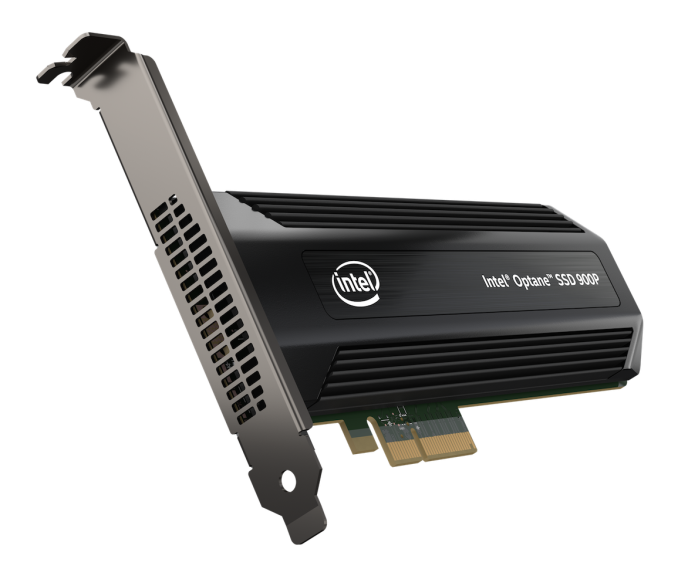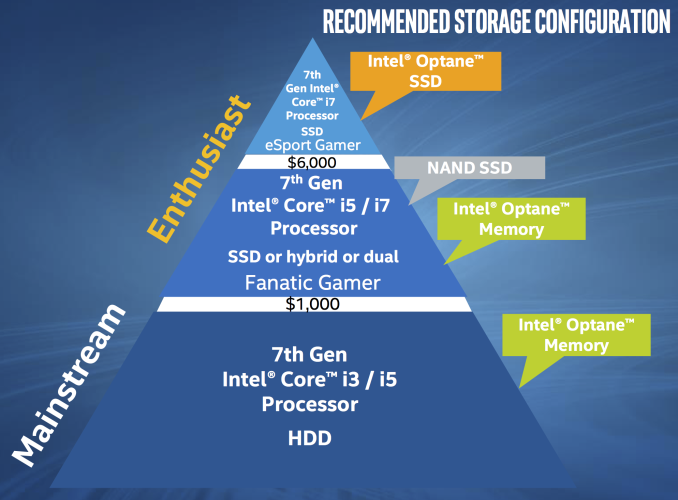The Intel Optane SSD 900P 280GB Review
by Billy Tallis on October 27, 2017 9:30 AM EST
Whenever Intel develops a new generation of SSDs based entirely on in-house technology, the result is usually a product that turns heads. Several times, Intel has set a new standard for SSD performance, starting with its original X25-M. Their most recent shake-up of the consumer SSD market was the Intel SSD 750, the first consumer NVMe SSD. Such significant releases don't happen every year, and in the intervening years Intel's competitors always catch up and surpass Intel.
However this year's revolution from Intel will be very hard for the competition to match anytime soon. All of Intel's previous record-setting SSDs have relied on the drive's controller to stand out from the crowd. This time, Intel's advantage comes from the storage medium: its 3D XPoint memory technology, a new nonvolatile memory that offers much higher performance than flash memory.
The Intel Optane SSD 900P
The new Intel Optane SSD 900P is a premium NVMe PCIe SSD offering the highest level of performance, with a moderate capacity. The Optane SSD 900P is intended for high-end desktop systems and workstations with very disk-heavy workloads. The Optane SSD 900P isn't for everyone and won't be displacing any existing products - it exists alone in a new product tier, with prices that are more than twice what the fastest flash memory based SSDs are selling for.
Optane is Intel's brand name for products featuring 3D XPoint memory. The Intel Optane SSD 900P is actually the third Optane product to be released, but it's the first family member to go after the high end consumer market segment. The Intel Optane Memory M.2 drives released earlier this year have capacities far too small for general-purpose storage use and instead have been marketed for use as a cache device to be paired with a mechanical hard drive. Intel's caching strategy works and can bring a hard drive's responsiveness up to the level of mainstream SSDs, but it has downsides. The Optane Memory caching requires a few extra steps to setup, and the caching software will only run on Intel platforms introduced this year: Kaby Lake or newer.
The Optane SSD DC P4800X is Intel's flagship enterprise SSD, and it is priced accordingly—putting it far out of reach of consumer budgets, and even with a price tag of over $1500 for 375GB it has been quite difficult to acquire. In the enterprise storage market, the P4800X has been highly sought after, but it isn't appropriate for all use cases and is not a threat to the many enterprise SSDs that prioritize capacity over performance and endurance.
The Optane SSD 900P will still cause some sticker shock for consumers expecting prices in line with M.2 PCIe SSDs, but it is acceptable for the kinds of machines that might be packing multiple GPUs or 10+ CPU cores. The Optane SSD 900P probably wouldn't be the only drive in such a system, but it would work well as a blazing fast primary storage device.
| Intel Optane SSD 900P Specifications | ||
| Capacity | 280 GB | 480 GB |
| Controller | Intel SLL3D | |
| Memory | Intel 128Gb 3D XPoint | |
| Interface | PCIe 3.0 x4 | |
| Form Factor | HHHL Add-in card or 2.5" 15mm U.2 |
HHHL Add-in card |
| Sequential Read | 2500 MB/s | |
| Sequential Write | 2000 MB/s | |
| Random Read IOPS | 550k | |
| Random Write IOPS | 500k | |
| Power Consumption | 8W Read 13W Write 14W Burst 5W Idle |
|
| Write Endurance | 10 DWPD | |
| Warranty | 5 years | |
| Recommended Price | $389 ($1.39/GB) | $599 ($1.25/GB) |
The Intel Optane SSD 900P is initially launching with 280GB and 480GB capacities. Both sizes will be available as PCIe 3.0 x4 half-height half-length add-in cards, and the 280GB model is also available as a 2.5" U.2 drive. Higher capacities may be added later, but Intel isn't promising anything yet. The sequential transfer speeds are nothing special for a NVMe SSD these days—Samsung's 960 PRO can hit much higher read speeds and slightly higher write speeds. The random read and write IOPS are far higher than any consumer SSD has offered before.
Intel's specifications for power consumption show one big reason why the Optane SSD 900P is a desktop-only product. Laptops are not equipped to supply up to 14W to a SSD, and they usually aren't equipped to cool a drive that idles at 5W instead of 50mW. The level of performance offered by the Optane SSD 900P cannot currently fit within the power budget or space constraints of a M.2 card.
The five year warranty Intel offers is typical for a high-end SSD in today's market, but doesn't compare to the 10 year warranty that Samsung's flagship 850 PRO SATA SSD offers. On the other hand, the 10 drive writes per day write endurance rating is far higher than most consumer SSDs get; 0.3 DWPD is more typical.
The Intel Optane SSD 900P starts shipping worldwide today, and here is our review of the 280GB version.











205 Comments
View All Comments
BrokenCrayons - Friday, October 27, 2017 - link
Yup, there's the ddriver we all know touting yet another set of unverifiable qualifications that proclaim relevant experience. From getting first pick of hard drives off the pallet at the shipyard to system security and now a decade of multiphysics simulation experience, this shamless self-promoter has done it all and is a SME in everything.It's too bad you're so transparently trying to set a new record in rigged life experiences. Shame!
ddriver - Friday, October 27, 2017 - link
You make a persuasive argument :)I criticize intel, that is great, therefore I suck, regardless of how grounded that criticism is.
You criticize me, who sucks, therefore you are great, like intel, regardless of how baseless your criticism is.
I wish I had such lowly and trivially attainable goals in life as you do. That would make things so much easier. I'd basically have to cheer and clap hands at my own stupidity to feel accomplished. Must be nice...
BrokenCrayons - Friday, October 27, 2017 - link
The number of times you've replied in this article alone make it clear you serve no useful purpose to the world.ddriver - Friday, October 27, 2017 - link
And I guess you responding to so many of my comments if just to whine about it makes you very useful, right? LOLCheapSushi - Friday, October 27, 2017 - link
Wouldn't be a AnandTech article without him. I pretty sure nearly every single one has some cynicism from him.ddriver - Friday, October 27, 2017 - link
Go and check and come back with the results.BrokenCrayons - Friday, October 27, 2017 - link
I like the Optane articles the best when it comes to ddriver. They predictably draw him out and while in the context of Optane, he's even easier to manipulate than usual.ddriver - Friday, October 27, 2017 - link
Oh wow, so you are manipulating me now. You mastermind you.Good thing I come out of my troll cave so you can ride that white steed of yours into glorious battle and once again find purpose in life, heroically championing for the dummies of mediocrity :)
All hail the brave sir Dumb-a-lot.
BrokenCrayons - Friday, October 27, 2017 - link
I can tell you feel like you've lost by the way you're resorting to childish name calling.sonny73n - Tuesday, October 31, 2017 - link
OMG ddriver. I've stopped reading your posts after page 3, but at page 8 now I'm still seeing your rantings. You definitely have serious issues.